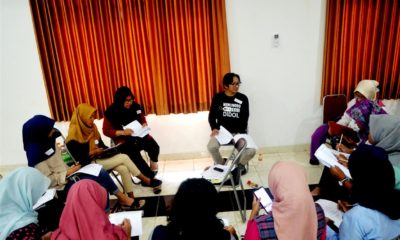Opinion
HIV-AIDS in Children
Published
4 years agoon
By
Mitra WacanaBy : Rizka Adhe Yuanita
HIV (Human Immunodeficiency Virus) is a virus that causes AIDS (Acquired Immunodeficiency Syndrome) Viruses damage or destroy immune cells, so immune cells are weakened and unable to fight against infection or cancer. According to World Health Organization (WHO) data, about 3.2 million children under 15 years of age are living with AIDS (at the end of 2013). The cause of most HIV infections in children the passing down through mother to child (i.e. it occurs due to transmission during the perinatal period – the period of pregnancy, during and after delivery).
Transmission to infants can also occur after birth through the mother’s milk (ASI). However, the existence of a treatment regimen is under-resourced. This includes the existence of materials used to determine diagnosis, prevent, reduce, eliminate, or cure disease, which in this case is devoted to the treatment and prevention of HIV / AIDS, to reduce the incidence of mother-to-child transmission. Since the mid 1990s, HIV testing and preventive drug regimens have resulted in a 90% reduction in the number of children infected with HIV in the United States.
In developing countries like Indonesia, the risk of HIV transmission from mother to child is estimated at around 21-43%. This figure is higher than the risk of transmission in developed countries, which can be estimated at around 14-26%. The highest risk of transmission occurs during labor (18%), in the womb (6%) and postpartum by (4%). According to data from the Republic of Indonesia Ministry of Health in the first quarter of 2015, the number of HIV-infected children in Indonesia reported by age group from 2010 to 2014 increased. The number of children infected in 2010 was 795, then in 2013 it reached 1075 children and in 2014 it reached up to 1388 children. During childbirth, babies can be infected with blood or vaginal fluid containing HIV through exposure to the virus that is ingested in the birth canal (Rumah Cemara, 2016).
Transmission of HIV through breast milk is a factor of transmission after delivery and doubles the risk of transmission because the liquid milk contains the HIV virus from the mother and is immediately ingested. Some factors that influence the risk of HIV transmission through breast milk include mastitis or nipple wounds, sores in the baby’s mouth, prematurity and infant immune function. Mothers with HIV who breastfeed their children have a higher risk of death than those who do not breastfeed. Some world bodies such as WHO, Unicef and UNAIDS recommend to avoid HIV-infected breast milk, if other milk alternatives are available.
It is also a concern when children suffering from HIV are alienated from family, friends, or even residents in their neighborhood. They may be viewed as frightening, as if carrying a curse. Children suffering from HIV need empathy and moral support from family, friends and those closest to them. The child’s community must be able to motivate them, to rise from adversity, not to be judged or stigmatised. Stigma for people with HIV / AIDS is more severe when compared with patients with other deadly diseases. Sometimes the stigma also falls on health workers or volunteers, who are involved in caring for people living with HIV-AIDS (PLWHA).
Discrimination and stigma by people in various parts of the world against AIDS sufferers include acts of exile, rejection, unfair treatment, divulging the confidentiality associated with HIV they experience and avoiding people suspected of being infected with HIV. These social punishments make children with HIV-AIDS anxious, which in turn causes physical and mental stress for the child.
Yogyakarta Special Region AIDS Commission reminds people not to exclude or discriminate against children with HIV-AIDS who are victims of their parents. They should recieve support from the community. Secretary of the AIDS Commission for Deerah Yogyakarta, Riswanto, said that people are still afraid of their children when they are suspected to be affected by HIV-AIDS, as they think that if their children associate with children who are exposed to HIV-AIDS, their children will be infected. That is due to the lack of public knowledge about HIV-AIDS.
In general, children with HIV-AIDS do not attend school, this is because there are no schools willing to accept students exposed to HIV-AIDS. Secretary of Yogyakarta Regional AIDS Commission Commission Bp. Riswanto hopes that no more schools will refuse to accept students who suffer from the impact of HIV-AIDS. To reduce the occurrence of infection in HIV-AIDS in children, parents who are at risk of being exposed to HIV-AIDS should have their children checked immediately, and take part in the “prevention of mother to child transmission of HIV (PMTCT)” program, such as in the Dr. Sardjito Yogyakarta.
Author’s Biography
Nickname : Rizka Adhe Yuanita
Gender : Woman
Religion : Islam
Email : rizkaadheyuanita@gmail.com
Organizational experience
- Wakil Bendahara Himpunan Mahasiswa Sosiologi 2017
- Bendahara Umum Himpunan Mahasiswa Sosiologi 2018
- Bendahara Retrociology 2016
- Sie Keamanan Gelar Budaya 2017
- Sie Keuangan Spectrum 2017
- Steering Commite (SC) PKKMB FISIP UNS 2018
You may like
News
Are American and Indonesian Women Really So Different?
Published
4 years agoon
7 February 2020By
Mitra Wacana
by Jacqueline Lydon – Volunteer internship Program Mitra Wacana
After growing up in the U.S., now living in Indonesia for about five months and interning at Mitra Wacana for three, I’ve been surprised at the similarities between conditions for women in the two countries.
On the surface level, women in the U.S. and Indonesia may seem like polar opposites.
When comparing the two, people tend to focus on the behaviors and appearances of women. Women are judged for how they dress, how they act, and how independent they are, for example.
Americans might judge Indonesian women for dressing conservatively, staying in the domestic sphere, and being seemingly submissive to their husbands. Meanwhile, Indonesians might judge American women for not covering their bodies, being too sexual, not focusing on domestic roles, or being too loud and demanding.
What I’ve noticed since being here is first, that these differences are less noticeable than I had thought, and second, that they seem to stem from differences in cultures and societal norms. There are different ways of understanding gender and gender roles, yet women in both America and Indonesia want safety, respect, and to have a voice.
There are many similarities between women’s behaviors and struggles in the two countries.
- 51.9% of Indonesian women are in the workforce, compared to 57.1% of U.S. women
- 17.4% of the Indonesian parliament is female, compared to 23.9% of the U.S. legislature
- The first Indonesian woman was elected president in 2001, while a woman has never yet been president in the U.S.
- The first female supreme court justice in Indonesia, Sri Widoyati Wiratmo Soekito, was inaugurated in 1968, while the first woman to join the U.S. supreme court was Sandra Day O’Connor in 1981, about 15 years later.
There are many issues – from sexual harassment to rape – that have a widespread impact on women in both countries, but it’s hard to have accurate statistics because many women do not or can not report these incidents. But based on what is reported, it’s clear that these are major issues in both countries.
- 3 out of 5 Indonesian woman and 81% of American women have experienced sexual harassment
- 15% of Indonesian women and more than 1 in 3 American women report being a victim of sexual violence
- 16% of Indonesan women and about 25% of women in the U.S. have reported being a victim of intimate partner violence (physical, sexual, or psychological violence from a partner or spouse)
With two countries in which women’s attitudes and behaviors seem so different, it’s surprising how similar women’s successes and struggles are.
Just last year, a poll in the U.S. found that only 29% of American women identify as feminists. (Feminist: someone who believes men and women should have equal rights.) In both countries, there are both feminist movements and anti-feminist movements (In the U.S., “meninism”; in Indonesia, “Indonesia tanpa feminisme”). In both, women’s voices are suppressed; women who advocate for themselves are often seen as too demanding, and their problems are ignored.
Why is there so much judgement for women’s choices in both countries?
Part of this is based on stereotypes, which are continually built up about women who act differently. Women in each country are taught that their culture’s roles, behaviors, and values are the better choice, and if only they stick to that, they will avoid the problems faced by women in different cultures. For example, women in the U.S. are taught that being more assertive will help them achieve more political representation, and women in Indonesia are taught that behaving modestly will help them avoid sexual violence or harassment. Yet the similarities in statistics prove that it is not the behaviors of women that cause these problems, and neither culture’s prescriptions for women will solve the issues.
Of course, there is not one simple answer for these systemic issues. But, the main culprit of sexism around the globe is the patriarchy – the system that has been constructed to empower men and subjugate women. It is this system that has created this notion of victim blaming – to judge and blame women for their own oppression instead of the overarching system.
Instead of looking at the choices of women or judging them, we should look at the system of patriarchy that is prevalent in both countries.
I think we need to stop focusing on the behavior of women and instead focus on the way that society judges and oppresses all women, and then build solidarity to break down those systems. The ideal of how a woman should be and should act may be different in both cultures, but it is universal that women should be free from violence and treated with dignity and respect.
Editor: Arif Sugeng W

Mitra Wacana Terima Penghargaan Hassan Wirajuda Pelindungan Award 2023 dari Kementrian Luar Negeri RI

Mitra Wacana Jalin Mou Kolaborasi bersama Komisi Informasi Daerah Yogyakarta











